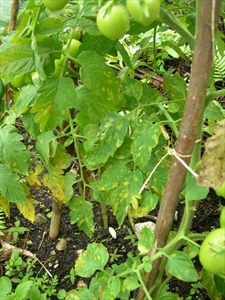- Worldwide distribution. In tropical and warm temperate countries. An important disease.
- Spots merge, leaves yellow and fall; defoliation is often rapid, and losses are high. Brownish spore masses on undersides of leaves. Worse where cool and wet.
- Spread occurs in air currents, water splash, on tools.
- Cultural control: avoid planting near older crops; remove lower leaves as trusses are harvested; collect trash and burn after harvest; tolerant varieties; at least a 3-year crop rotation.
- Chemical control: copper, mancozeb or chlorothalonil. Start when spots seen, and continue until 3-4 weeks before last harvest.






